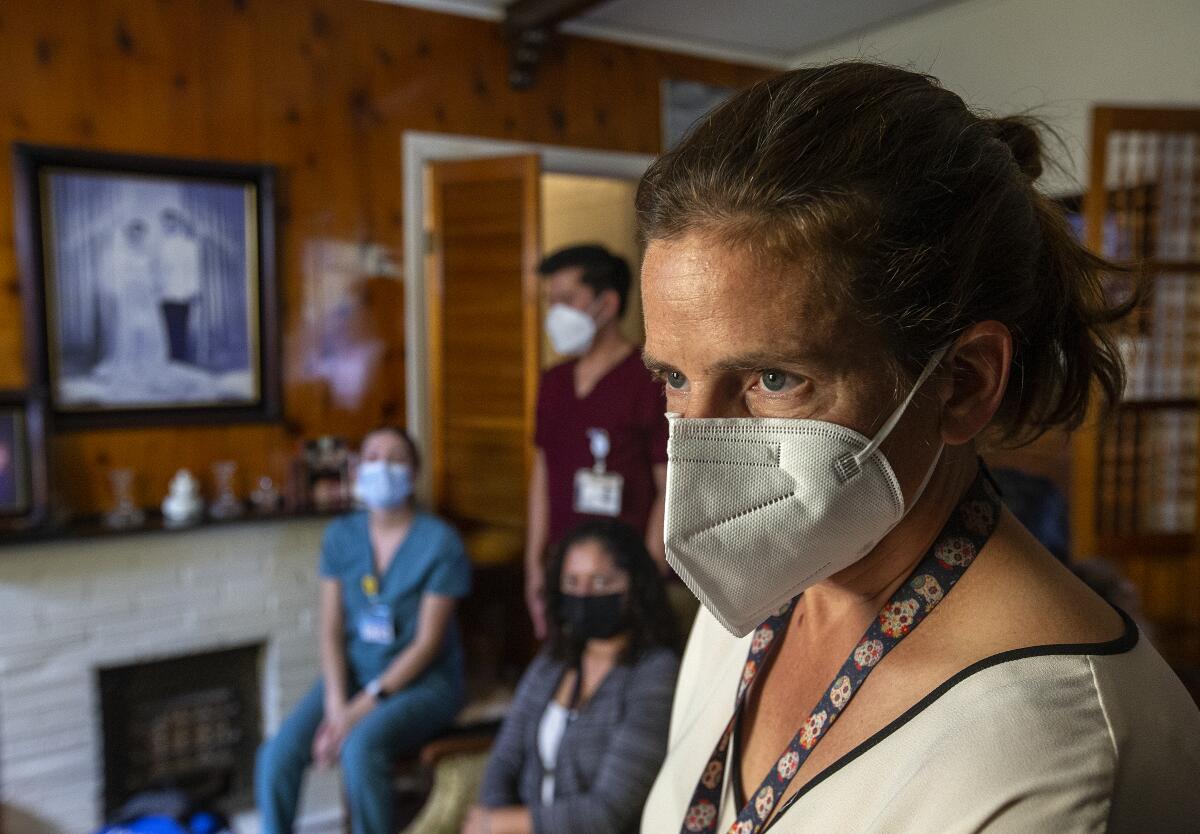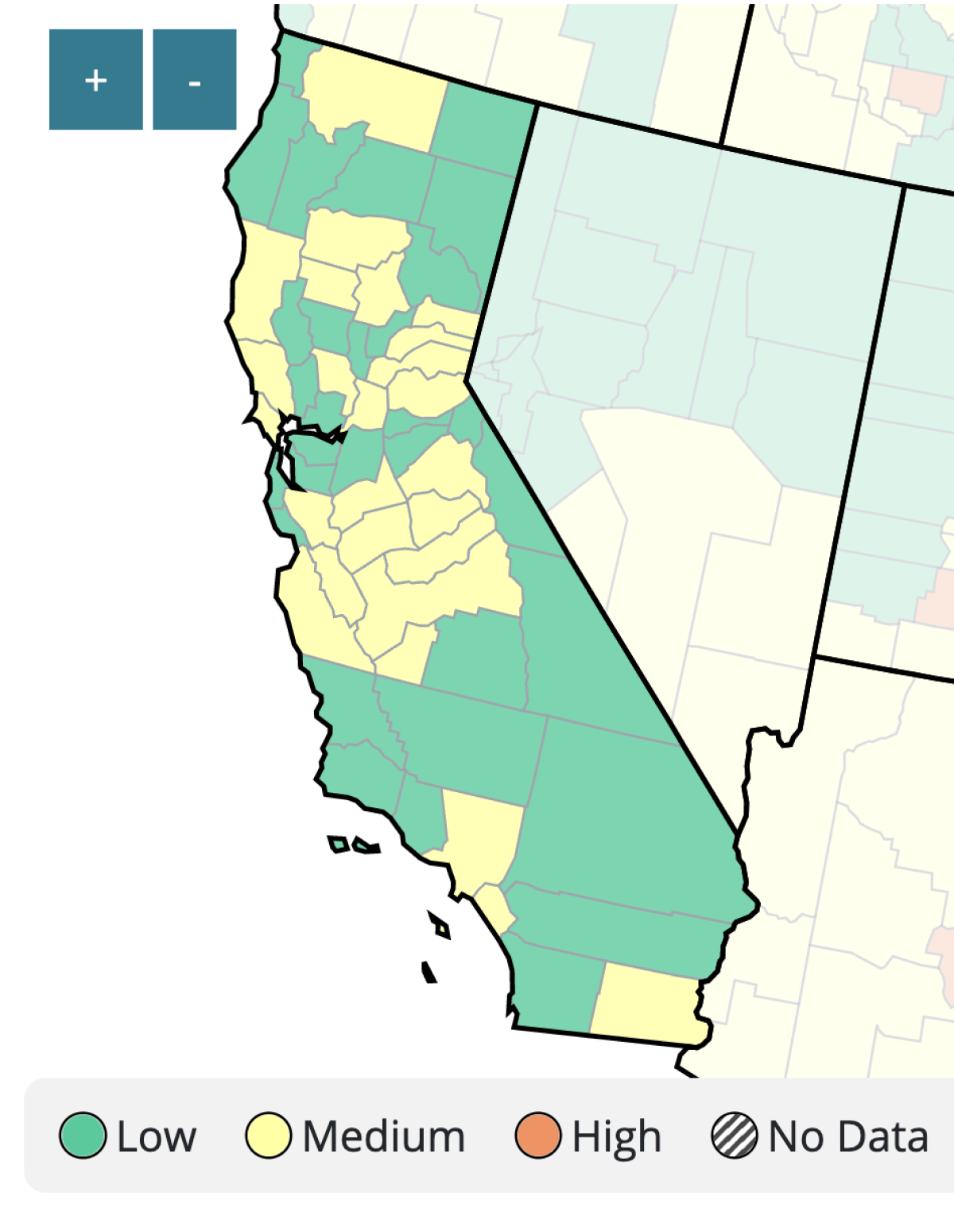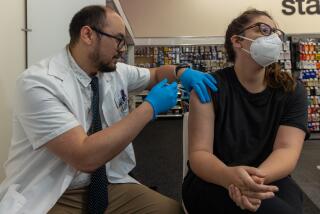California senior citizens are hit hard as COVID-19 surges this winter

There has been a troubling spike in coronavirus-positive hospital admissions among seniors in California, rising to levels not seen since the summer Omicron surge.
Hospitalizations have roughly tripled for Californians of most age groups since the autumn low. But the jump in seniors in need of hospital care has been particularly dramatic.
Officials in Los Angeles County have said increases in hospitalizations could lead to an indoor mask order, possibly in early January. Still, there is optimism that any winter surge will not be as bad as those of the last two years.
Rising hospitalization rates are a reason health officials are urging people, especially seniors, to get the updated COVID-19 booster shot and, if they test positive and are eligible, to access therapeutic drugs that likely will reduce the severity of any illness.
Only 35% of California’s vaccinated seniors age 65 and up have received the updated booster since it became available in September.
Among eligible 50- to 64-year-olds, about 21% have received the updated booster. The rate is 12% for younger adults, 9% for adolescents and 8% for 5- to 11-year-olds. The updated booster rate for all vaccinated Californians age 5 and up is 18%.
“We are doing a pathetic job of protecting seniors (and age 50+) from severe COVID in California,” tweeted Dr. Eric Topol, director of the Scripps Research Translational Institute in La Jolla.
Immunity against COVID-19 weakens over time. The booster is especially important for older people, who are at higher risk for severe illness and death.
“The people who are dying today are principally people who are unvaccinated or haven’t gotten an up-to-date vaccine,” Xavier Becerra, the U.S. Health and Human Services secretary, said Thursday in an online forum with the Public Policy Institute of California.
COVID-19 deaths in the state have remained stable at 100 to 200 a week. However, there is concern that increases in cases and hospitalizations could lead to more fatalities.
Of all age groups, 70-plus is the only one that is seeing its hospitalization rate in California exceed that of the summer Omicron peak, according to the U.S. Centers for Disease Control and Prevention.
New coronavirus-positive hospitalizations have doubled in just 2½ weeks to 8.86 for every 100,000 Californians age 70 and up. The summer peak, in July, was 8.36; the autumn low, just before Halloween, was 3.09.
During the seven days to Friday, 2,450 coronavirus-positive Californians age 70 and up were admitted to hospitals — 44% more than in the prior week.
Meanwhile, the hospitalization rate for 60- to 69-year-olds has doubled since Nov. 11, from 1.28 to 2.59. The summer peak for that age group was 3.03.
Concerned about the rise in cases and hospitalizations, state health officials issued an alert to remind doctors that there are plenty of drugs available for newly infected people.
“There is ample supply of COVID-19 therapeutic agents, but they have been underused — especially among populations disproportionately impacted by COVID-19, including communities of color, low-income communities, and residents of long-term care facilities,” the California Department of Public Health said.
The drugs can reduce the risk of hospitalization and death by 88% among unvaccinated people and by 45% among vaccinated or previously infected people, the agency said.
The drugs “are free and widely available,” said Orange County Health Officer Dr. Regina Chinsio-Kwong in a statement. “Medications such as the Paxlovid pill can stop the virus from multiplying in your body, help you test negative sooner, and may lower the risk of developing long COVID symptoms. Additionally, you do not need to have insurance or U.S. citizenship.”
Other therapies against COVID-19 are becoming effectively useless. On Wednesday, the U.S. Food and Drug Administration said it was no longer authorizing the monoclonal antibody bebtelovimab to treat the disease because it’s not expected to work against the Omicron subvariants BQ.1 and BQ.1.1.
CDC data released Friday estimate that BQ.1 and BQ.1.1 account for 62.8% of coronavirus cases nationwide. The parent strain, BA.5, now accounts for just 13.8% of cases.
The coronavirus outlook has deteriorated rather suddenly since Thanksgiving around swaths of California.
The worsening rate “indicates a higher risk for more individuals to catch COVID-19 this winter,” Chinsio-Kwong said. She urged people to mask up in indoor public settings.
On Nov. 17, all but one of California’s 58 counties — Imperial — was in the low COVID-19 community level as defined by the CDC, which measures case and hospitalization rates. On Thanksgiving, three more counties — Fresno, Madera and Del Norte — joined Imperial in the medium category.
On Thursday, 23 counties entered the medium level: Los Angeles, Orange, Santa Clara, Sacramento, Stanislaus, Sonoma, Monterey, Placer, Merced, Marin, Yolo, Butte, El Dorado, Kings, Nevada, Mendocino, Tehama, San Benito, Tuolumne, Siskiyou, Glenn, Mariposa and Sierra.
About 22 million people, 55% of Californians, live in counties now at the medium level.

In L.A. County, coronavirus cases rose nearly 50% during the last week, from 2,049 to 3,053 a day. The county’s rate has been increasing since late October and is more than triple what it was in the autumn. For the week that ended Friday, L.A. County was recording 212 cases for every 100,000 residents; a rate of 100 or more is considered high. The COVID-19 death rate in L.A. County is stable at around 60 per week.
Besides COVID-19, L.A. County is contending with rising flu cases and a high level of respiratory syncytial virus, which is stressing children’s hospitals. The flu positivity rate in L.A. County is 25%, the highest for this time of year for at least six years.
For L.A. County to reinstate a mask mandate, two hospitalization thresholds need to be met. One has already been reached.
There were 1,285 admissions of coronavirus-positive patients to county hospitals for the week that ended Wednesday — more than triple the rate from the beginning of November. That’s 12.8 for every 100,000 residents, and a rate of 10 or greater is one of the thresholds for a mask mandate.
The other threshold is reached if the percentage of hospital beds used by coronavirus-positive patients is 10% or greater, an indication of strain on the hospital system. This level was reached during the 2020 and 2021 winter surges, the deadliest of the pandemic.
The current figure is 5.9%, up from around 2% at the start of November. The earliest the level could hit 10% would be late December, L.A. County Public Health Director Barbara Ferrer estimated last week.
If that happens, there would likely be a two-week countdown before a mask order would take effect — thus, early January at the soonest.
Elsewhere, Orange County’s coronavirus-positive hospitalization rate has doubled since mid-November to 432 per week, according to the CDC, or 13.6 for every 100,000 residents. Orange County reports that 4.9% of hospital beds are being used by coronavirus-positive patients.
More to Read
Start your day right
Sign up for Essential California for news, features and recommendations from the L.A. Times and beyond in your inbox six days a week.
You may occasionally receive promotional content from the Los Angeles Times.







